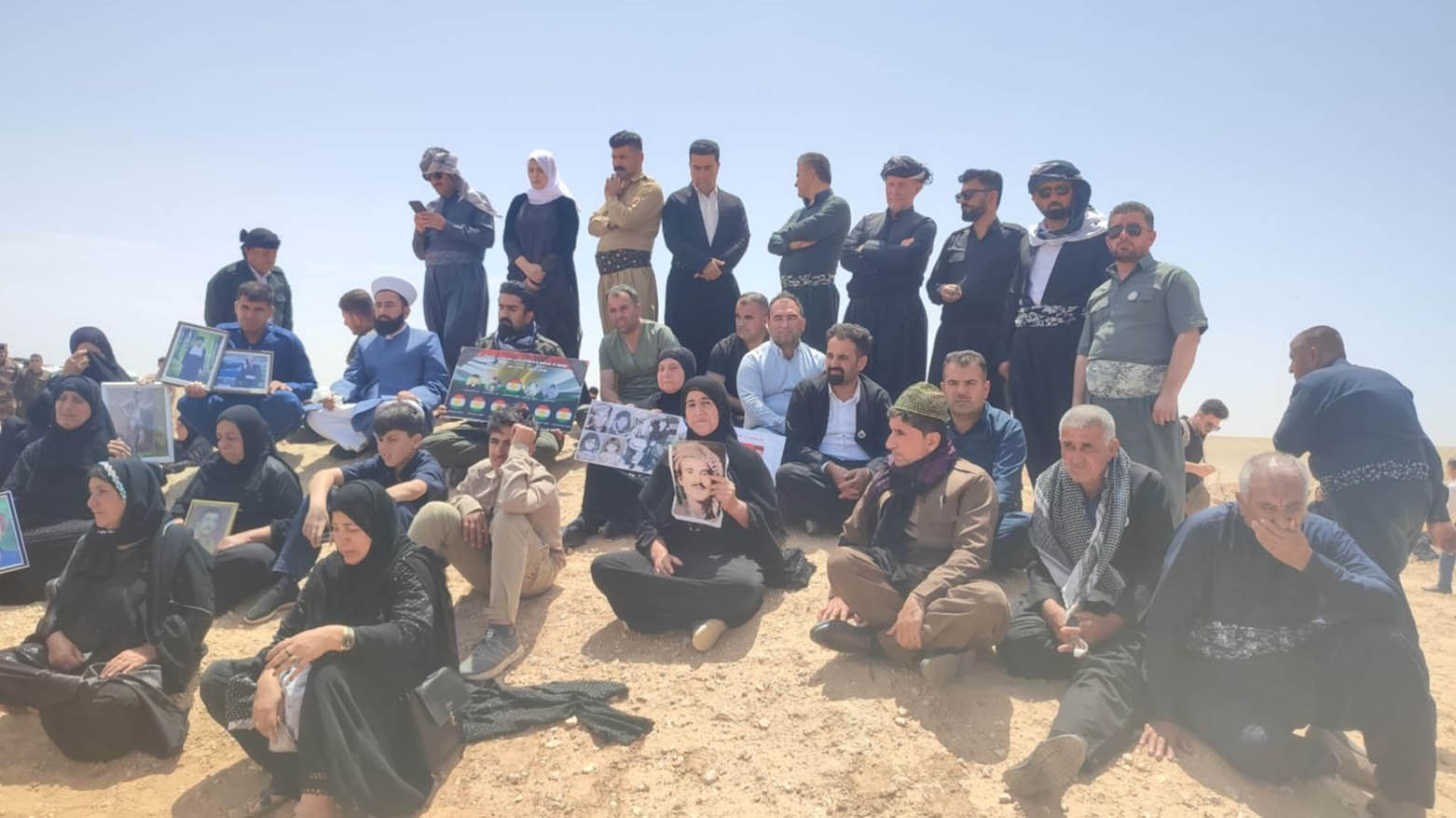'They Buried Us in the Desert, Now We Return for Justice', Say Anfal Families
On Monday morning, the delegation visited Nugra Salman prison in Iraq’s southern desert—an infamous Anfal-era site of Kurdish suffering. Hamid, once imprisoned there as a child, called the return “deeply traumatic,” saying, “It sent shivers down my spine.”

By Kamaran Aziz
ERBIL (Kurdistan24) – In a powerful display of memory and resistance, over 200 family members of Anfal victims from Garmiyan, Kirkuk, Chamchamal, Koya, and other regions gathered in Baghdad and Nugra Salman this week, demanding justice, compensation, and the return of their loved ones’ remains.
On Sunday, April 20, 2025, the families assembled outside the Iraqi Martyrs' Institution in Baghdad, voicing urgent demands for long-denied rights. Among them were calls for the exhumation and repatriation of Anfal victims’ remains to the Kurdistan Region, financial compensation, and equal treatment in pensions and benefits with the families of other Iraqi martyrs.
Speaking to Kurdistan24, Aso Hamid, an Anfal survivor, recounted the emotional impact of the visit. “Yesterday, Sunday, we went to the Martyrs' Institution in Baghdad, numbering more than 200 people. Families of Anfal victims from Garmiyan, Kirkuk, Chamchamal, Koya and several other places were together. In front of the Martyrs' Institution in Baghdad, we demanded the exhumation of Anfal remains and the return of our remains to the Kurdistan Region. We also demanded that the salaries of families of martyrs and Anfal victims be made equal to those of Iraqi martyrs, as well as compensation for families of Anfal victims.”
On Monday morning, the delegation visited Nugra Salman prison in the southern desert of Iraq—an infamous site of Kurdish suffering during the Anfal campaign. Hamid, who was once imprisoned there as a child, described the return as deeply traumatic. “I spent part of my childhood in that prison, and when I visited that place again, it sent shivers down my spine.”
According to the Kurdistan Memory Programme, Nugra Salman became one of the most feared and secretive sites of incarceration during the Anfal campaign. More than 3,000 women, children, and elderly civilians were transported in military convoys from the north to this remote desert prison, located in Muthanna Governorate. Families were confined in dark, windowless rooms under unbearable heat, where malnutrition, dehydration, and untreated disease were rampant. Survivors recall children dying daily from dysentery and thirst. Guards refused to acknowledge inmates’ existence, and no judicial process was afforded to any prisoner.
Personal testimonies from survivors collected by the Kurdistan Memory Programme reveal unimaginable suffering. Fatima Khursheed Mahmoud described the constant threat of death, recalling how her father and brother were taken away by security forces and never returned. Miriam Rashid Mahmoud, who was held at Nugra Salman, remembered being told by guards that “the wolf took your men,” an ominous euphemism for execution. Women were often forced to bury their children with their own hands, as Aisha Ismael Ali recounted after losing five of her six children in the chemical attack on Goptapa.
Other testimonies highlight the deception and cruelty of Iraqi soldiers. Mahroob Mohammed Nawkhas was told her family was being relocated, only to be imprisoned instead. Osman Ali Aziz and Abdulrahman Abdullah Salih recalled the annihilation of entire villages in the Lesser Zab valley and the systematic targeting of communities that supported the Kurdish resistance. The absence of judicial records and the regime’s denial of basic dignity made Nugra Salman a site not just of incarceration, but erasure.
The visit underscored both the physical and psychological scars left by the Anfal genocide, a systematic campaign of extermination conducted by Saddam Hussein's Baathist regime in 1988. In a series of eight phases spanning multiple offensives, the regime targeted Kurdish civilians, destroying over 4,000 villages and arresting approximately 182,000 individuals—many of whom were later buried alive in mass graves across Iraq’s central and southern deserts.
The campaign began in February 1988 in the Jafayati Valley and concluded with the final stage in Badinan between August 26 and September 6 of the same year. The brutality extended beyond the mass killings to include widespread looting, forced displacement, and destruction of cultural heritage.
Their protest was not merely about memory, but about the enduring inaction and silence of the Iraqi state. “We want to know how long the Iraqi government will continue to ignore the decisions of the High Criminal Court,” one relative of an Anfal victim said. “How long will they avoid apologizing and compensating us?” These words echoed a sentiment of intergenerational frustration and loss—remains still unreturned, justice still denied.
Nugra Salman, one of the regime's most notorious detention centers, is situated in Iraq’s southern Muthanna Governorate, near the village of Salman, roughly 1.5 kilometers from the Saudi border. Built in 1930 during the monarchy, the prison has a long, dark history and was later repurposed by the regimes of Abdul Karim Qasim and Saddam Hussein to detain political prisoners, including Kurdish civilians during the Anfal operations.
As noted by the Kurdistan Memory Programme, the site remains a haunting testament to the regime's deliberate effort to annihilate Kurdish identity. Its continued neglect by state authorities reflects not only historical denial but also the lack of post-genocide reconciliation efforts.
The families’ demands highlight a painful chapter of modern Iraqi history that remains unresolved. Despite repeated recognition of the Anfal campaign as an act of genocide, survivors and their families continue to await full justice, state recognition, and reparation. The sharp contrast between the treatment of Anfal victims and other categories of Iraqi martyrs only deepens their grievance.
Their presence in Baghdad, and their journey into the scorched sands of Nugra Salman, signal not only remembrance—but a call to conscience. For many Kurds, these sites are not just relics of the past, but living symbols of suffering, struggle, and the unyielding demand for truth and dignity.
